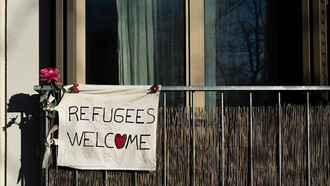Sometime back, I watched a viral disturbing video clip in the Kenyan internet space. The clip compelled me to interrogate and even doubt the capacity and possibility of social media activism. In particular, it made me question whether, as Kenyans, we essentialize the political power of social media amidst the ongoing protests. Are we using social media platforms in the ideal or appropriate way to stage active and successful resistance against dominant and hegemonic forces? I have re-watched the video several times guided by these questions, and my conclusion has consistently been that while social media platforms promise and deconstruct the political space for accessibility to multiple voices, especially the marginal ones that would otherwise be confined in subaltern conditions, their effectiveness in staging a successful political action for resistance remains problematic.
Perhaps, I should begin with contextualizing the video within the current Kenyan political climate, and then provide its synopsis, for the argument that I intend to make here relies heavily on these. Over the last three months, the Kenyan political sphere has been turbulent, typified by demonstrations and protests over bad governance, massive corruption, alarming unemployment rates, increased cost of living, etc. Dubbed the Gen-Z Revolution, these protests have targeted President William Ruto’s government, with some sections of the voices calling for his resignation. On June 25, 2024, the Gen-Z-led protest peaked when Kenyan youths stormed the Parliament, forcing the members of parliament who had passed the controversial 2024 Finance Bill to scamper and run for safety. A section of the parliament was set ablaze by the protestors, who had made their voice heard.
This is the current political climate, and even as the sitting government now seeks security and comfort through unpopular political realignments with the opposition, it is a fact that the State stands precariously with one of its feet stepping on a landmine. Notably, social media platforms such as Twitter, TikTok, Facebook, WhatsApp, and YouTube have been instrumental in building the current political moment, granting the youths and the citizenry the voice and power to challenge the State. Many of the protests, such as #OccupyParliament or #OccupyJKIA have relied on social media platforms for mobilization and calling the citizenry to action. The success of these protests, organized and mobilised online, has confirmed to Kenyans that social media platforms are critical and essential in political action in the current age. Hence, there is an increased reliance on social media to solve every social and political discomfort.
The success of such digitally engineered activism exists within a deconstructed approach to understanding political power. This is supported by James C. Scott, a power theorist, in ‘The Everyday Forms of Resistance’ about the fluidity of power. For a long time, the State has ignored digital platforms, and this has provided the governed with new spaces outside the public space to engage in political discourse. In this case, social media provides a shift from the mainstream reliance on public space in political action by providing a virtual space, where active mobilisation and a call to action occur. Indeed, as Scott argues, these new spaces, insofar as they are ignored or unnoticed by the government, demonstrate tactical wisdom from their users. Billie Jeanne Brownlee’s New Media Revolution Resistance and Dissent in Pre-uprising Syria, in particular, argues that the Syrian case and the entire Arab Spring did not happen in a vacuum. The conditions and moods for these uprisings were set earlier by the emergence and use of new media decades before even the actual protests.
In awareness of the power that social media carries with it as ‘an everyday form of resistance,’ there is also a fact of its misuse or lack of an understanding of its mechanism, which makes it a threat to political action. I began by bringing your attention to a viral video, which I will now offer its synopsis. The clip is shot in Nairobi, and the language used is Swahili and Sheng (the latter is a hybrid fusion of Swahili and other languages). If you watch it, it was recorded by a Kenyan youth who is convinced that the mere recording or documenting of a social injustice is fundamental to resistance, or a form of political action. In the video clip, a young man is being manhandled by a plain-cloth police officer. This young man is under arrest, and the scuffles and struggles between him and the cop raise public attention. Thus, there is a crowd that is observing the skinny young man being manhandled and roughed up by a well-built and burly cop. The young man’s offense, as per the cop, is obstructing justice. Behind the scenes, a friend of his has been arrested, accused of assaulting a woman. Now, the cop also intends to arrest this young man, claiming that he tried to obstruct the arrest of his friend.
The young man insists he is innocent. He is resisting his arrest because the cop already has the suspect (his friend) in their custody, so there are no grounds for arresting him for a crime that he did not commit. To put it in context, this rogue cop intends to arrest this young man for a crime his friend committed but is lying to the public that he was obstructing justice. The young man appeals to the crowd as his witness, asserting his innocence. The crowd agrees with him, the rogue cop is in the wrong. Typical of a rogue cop, a physical confrontation emerges, and the young man is wrestled to the ground. The rogue cop is joined by some other rogue cops to physically manhandle the young man. It is here that things get interesting. The crowd stays away from the incident. They are observing. The young man pleads with the crowd for help. You can see that the crowd sympathize with him as a victim of police brutality and extrajudicial force, but certainly will not step in to act in his most urgent time of need.
The young man asks, ‘Manze mnaona nikibebwa?’ (Guys! Are you guys watching while I am being manhandled/wrongfully arrested?). The person who is recording this says, ‘Tutakutetea kwa internet’ (We will fight for you through the internet, or online, or social media, among other close meanings of his words). Ridiculous, isn’t it? The guy recording clearly understands and believes in the power of social media to stage protests or in activism. His rationale for recording is to expose the rogue police for public scrutiny, where Kenyan online users will later call and demand the immediate release of the young man as soon as they log in to their various social media platforms. This is conditioned on the video going viral. However, the problem is that George Floyd was murdered in a similar situation to this while in the custody of rogue police officers. Floyd, like this Kenyan young man, asked for immediate and urgent assistance from the public. Unfortunately, he did not get the help. Instead, his death while in custody was recorded, and shared online, sporadically staging the biggest social media protests ever witnessed in the digital age. What if this young Kenyan man also died in custody like George Floyd? Would the recording be of help to him? Was it ever of help to him in the first place?
The problem with social media in activism is the users’ failure to understand how it works, how it should be used, and where it is active or most effective. The challenge here is to separate the active, physical, and confrontational manifestations of power from its virtual manifestations. In the case of this young Kenyan man, and that of George Floyd, an active and immediate political force was required to prevent a social injustice from occurring instead of enabling it through recording. Social media platforms work through mobilization for political action, and paving the way for reactions. Therefore, there is a time gap that it creates, which can only be filled with immediate and physical power manifestation. There is time to act, and there is time to record and document. These times must be understood so that the potential of social media is not wasted. Failure to understand these realities presents the risk of social media abetting or enabling the very social and political injustices that it seeks to prevent.















